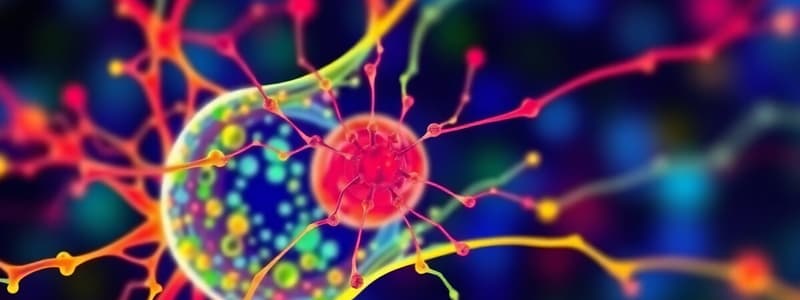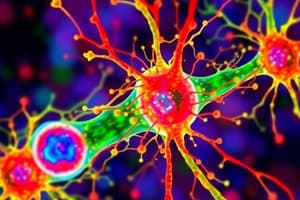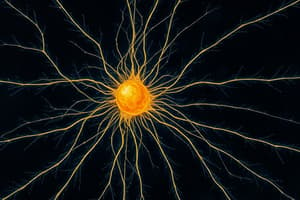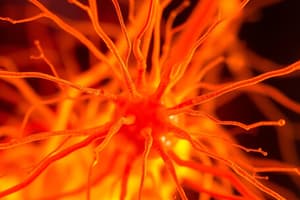Podcast
Questions and Answers
What is the diameter of microtubules?
What is the diameter of microtubules?
- 15 nm
- 7 nm
- 200 nm
- 25 nm (correct)
Which protein primarily composes microfilaments?
Which protein primarily composes microfilaments?
- Collagen
- Tubulin
- Actin (correct)
- Myosin
Which of the following processes is NOT supported by microtubules?
Which of the following processes is NOT supported by microtubules?
- Vesicle movement
- Cell differentiation (correct)
- Pigment vesicle movement
- Cytokinesis
How many protofilaments form a microtubule?
How many protofilaments form a microtubule?
What role do centrioles play in the context of microtubules?
What role do centrioles play in the context of microtubules?
What is the primary function of microfilaments in muscle contraction?
What is the primary function of microfilaments in muscle contraction?
Which of the following is NOT a function of microtubules?
Which of the following is NOT a function of microtubules?
What is the primary structural feature of microfilaments?
What is the primary structural feature of microfilaments?
What is the primary role of actin in microfilaments?
What is the primary role of actin in microfilaments?
Which type of protein makes up the majority of intermediate filaments?
Which type of protein makes up the majority of intermediate filaments?
What is the primary function of the cytoskeleton in a cell?
What is the primary function of the cytoskeleton in a cell?
What are the diameters of microfilaments compared to intermediate filaments?
What are the diameters of microfilaments compared to intermediate filaments?
How do microfilaments facilitate cell movement?
How do microfilaments facilitate cell movement?
Which statement about microtubules is correct?
Which statement about microtubules is correct?
What function do centrioles serve during cell division?
What function do centrioles serve during cell division?
What role do intermediate filaments play in epithelial cells?
What role do intermediate filaments play in epithelial cells?
How does the cytoskeleton contribute to cellular movement?
How does the cytoskeleton contribute to cellular movement?
Which protein is NOT included in type III intermediate filaments?
Which protein is NOT included in type III intermediate filaments?
Why are microfilaments important in white blood cells?
Why are microfilaments important in white blood cells?
Which statement is true regarding microfilaments?
Which statement is true regarding microfilaments?
What distinguishes microtubules from both microfilaments and intermediate filaments?
What distinguishes microtubules from both microfilaments and intermediate filaments?
What are centrioles primarily involved in?
What are centrioles primarily involved in?
What structural arrangement is characteristic of cilia and flagella?
What structural arrangement is characteristic of cilia and flagella?
In intestinal epithelial cells, what type of cytoskeletal element provides shape to the villi?
In intestinal epithelial cells, what type of cytoskeletal element provides shape to the villi?
Flashcards
Cytoskeleton Components
Cytoskeleton Components
The cytoskeleton is a network of protein filaments, including microtubules, microfilaments, and intermediate filaments, that gives cells shape and support.
Microtubules
Microtubules
Hollow tubes made of tubulin protein; important for cell shape, movement (cilia, flagella), and intracellular transport.
Microfilaments
Microfilaments
Thin, solid filaments of actin protein; crucial for cell shape, muscle contraction, and cell division.
Intermediate Filaments
Intermediate Filaments
Signup and view all the flashcards
Centrioles
Centrioles
Signup and view all the flashcards
Cilia
Cilia
Signup and view all the flashcards
Flagella
Flagella
Signup and view all the flashcards
9 + 2 arrangement
9 + 2 arrangement
Signup and view all the flashcards
Microfilaments Diameter
Microfilaments Diameter
Signup and view all the flashcards
Microfilaments: Actin and Myosin
Microfilaments: Actin and Myosin
Signup and view all the flashcards
Microfilaments: Cell Shape and Movement
Microfilaments: Cell Shape and Movement
Signup and view all the flashcards
Intermediate Filaments: Diameter
Intermediate Filaments: Diameter
Signup and view all the flashcards
Intermediate Filaments: Diversity
Intermediate Filaments: Diversity
Signup and view all the flashcards
Intermediate Filaments: Keratins
Intermediate Filaments: Keratins
Signup and view all the flashcards
Centrosome: Location
Centrosome: Location
Signup and view all the flashcards
Centrioles: Cell Division
Centrioles: Cell Division
Signup and view all the flashcards
Cytoskeleton
Cytoskeleton
Signup and view all the flashcards
Microfilament (Actin filament)
Microfilament (Actin filament)
Signup and view all the flashcards
Cytoskeletal function
Cytoskeletal function
Signup and view all the flashcards
Protofilaments
Protofilaments
Signup and view all the flashcards
Cilia and flagella
Cilia and flagella
Signup and view all the flashcards
Dynein arms
Dynein arms
Signup and view all the flashcards
Cell motility
Cell motility
Signup and view all the flashcards
Study Notes
Non-membranous Cell Organelles (Cytoskeleton)
- The cytoskeleton is a complex, dynamic network of interlinking protein filaments found in the cytoplasm of all cells (including bacteria and archaea).
- In 1903, Nikolai Koltsov proposed the cytoskeleton determines cell shape.
- It extends from the cell nucleus to the cell membrane and consists of similar proteins in many organisms.
- Its primary function is to give the cell its shape and mechanical resistance, preventing deformation.
- It aids in intracellular transport of vesicles and organelles.
- The cytoskeleton can act as a template for the construction of a cell wall and specialized structures such as cilia and flagella.
Objectives
- Students should be able to list the components of the cytoskeleton.
- Students should be able to define the structure and function of microtubules.
- Students should be able to define the structure and function of microfilaments.
- Students should be able to define the structure and function of intermediate filaments.
- Students should be able to define the structure and function of centrioles.
Microtubules
- Microtubules are long, hollow, cylindrical and filamentous structures found in the cytoplasm of eukaryotic cells, absent in prokaryotes.
- Microtubules are found in thrombocytes (blood platelets) of humans and rats.
- They are 25 nm in diameter and 200 nm to 25 μm in length.
- Microtubules are major components of the cytoskeleton, and are involved in mitosis, cell motility, intracellular transport, and maintaining cell shape.
- They are composed of alpha- and beta-tubulin subunits assembled into linear protofilaments.
- These two units are arranged alternately in the protofilament.
- 13 protofilaments fold to form a cylindrical microtubule.
- Microtubules function as a supporting framework, giving shape to the cell, maintaining shape of long processes like cilia, flagella, and axons in nerve cells. They also create motion in cilia and flagella. Centrioles are identical in structure to basal bodies of cilia or flagella. Microtubules change cell shape during differentiation and help elongate certain cells.
Microfilaments
- Microfilaments, or actin filaments, are solid protein rods.
- Their diameters are about 7 nm, making them the smallest of cytoskeletal filaments.
- Actin is the protein that composes these filaments.
- Actin filaments serve as a track for the movement of myosin, a motor protein.
- Actin and myosin are abundant in muscle cells, and when actin and myosin filaments slide past each other, muscle contraction occurs.
- Microfilaments provide rigidity and shape to the cell.
- These filaments can rapidly assemble and disassemble, allowing cells to change shape and move.
- White blood cells use this ability for phagocytosis and movement.
Intermediate Filaments
- Intermediate filaments (IF) have a diameter of about 10 nm.
- IFs are composed of a variety of proteins expressed in different cell types.
- Over 50 different intermediate filament proteins are identified and classified into six groups based on similarities in amino acid sequences.
- Types I and II keratins form structural elements like hair, nails, and horns.
- Other types I and II keratins, or soft keratins, are found in the cytoplasm of epithelial cells.
- Type III IFs include vimentin, found in fibroblasts, smooth muscle cells, and white blood cells.
- Type IV intermediate filaments include neurofilament (NF) protein.
- Type V intermediate filaments are nuclear lamins.
Centrioles
- The centrosome is the barrel-shaped organelle in the cytoplasm near the nucleus.
- Two centrioles reside within the centrosome.
- Centrioles are crucial for cell division.
- During cell division, they move to opposite ends of the nucleus.
- As chromosomes condense for mitosis, centrioles form the areas from which mitotic spindles are made.
- Mitotic spindles attach to chromosomes and pull them to opposite ends of the cell, enabling cytokinesis.
- The centrosome's function is maintaining an equal distribution of chromosomes in daughter cells.
- Centrosomes are made of microtubule components arranged in sets of nine, each comprising three microtubules (9+3 arrangement).
- Centrioles are oriented at 90-degree angles to each other.
- Centrosomes are present in animal cells but not in plant cells.
- Centrioles are also known as basal bodies, as they are located at the base of cilia and flagella.
Studying That Suits You
Use AI to generate personalized quizzes and flashcards to suit your learning preferences.




